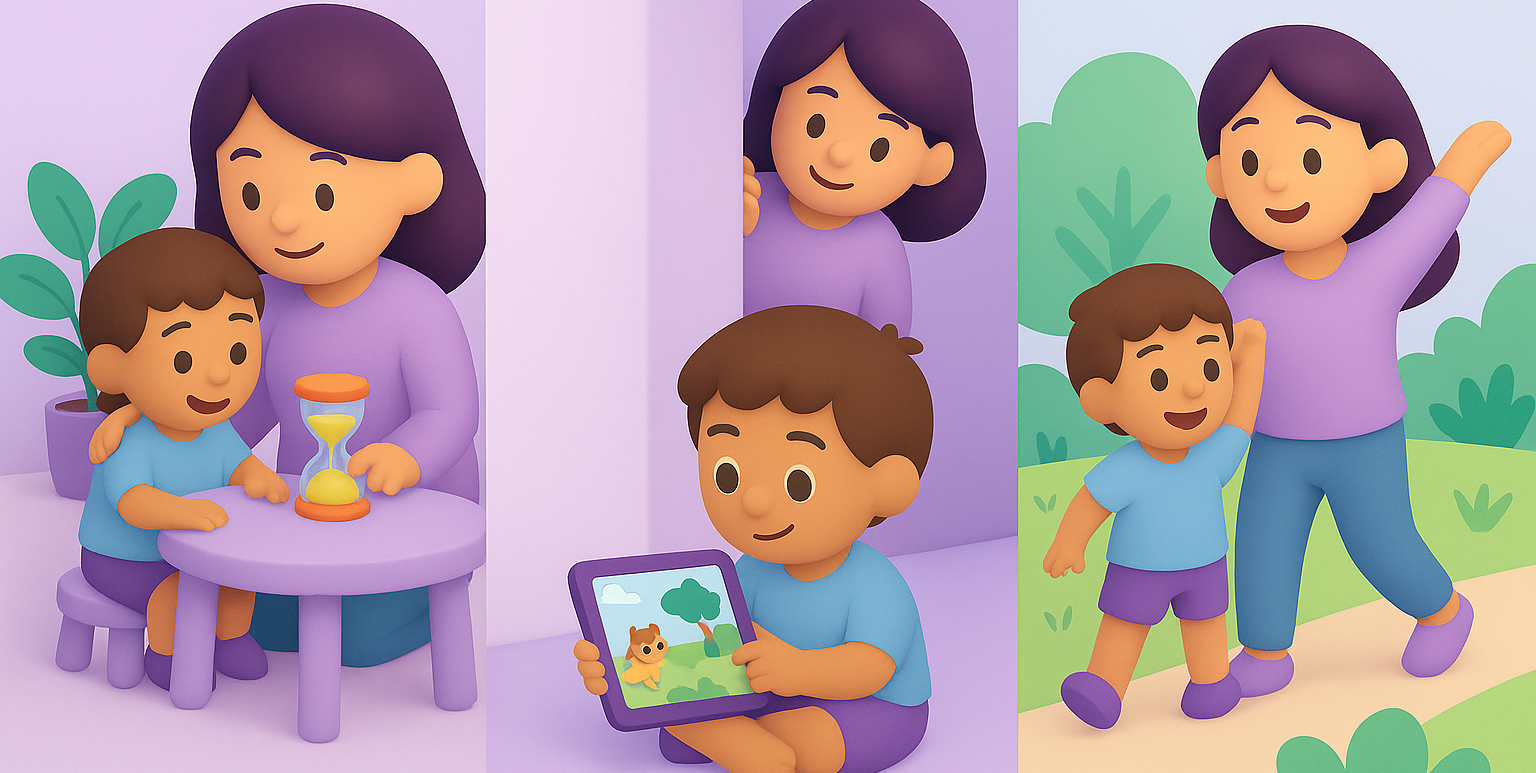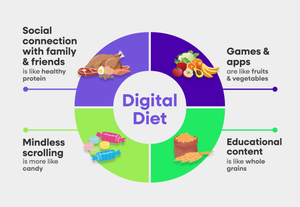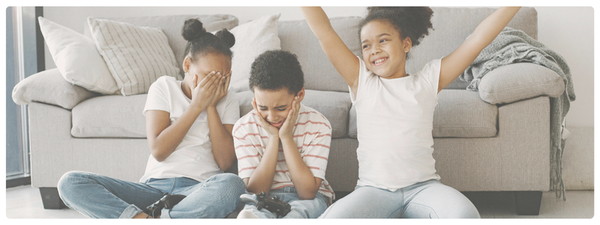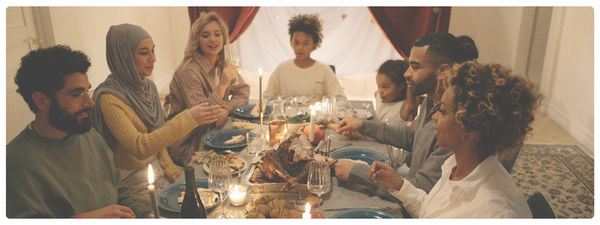"Emotional parenting" might sound like a new trend, but it’s deeply rooted in what developmental science has long supported: children thrive when they feel seen, heard, and guided.
While the phrase itself isn’t a formal parenting style, the skills it describes, such as validation, co-regulation, and emotional literacy, are essential tools in a modern digital parent and caregiver’s toolkit. These are the same qualities that define authoritative parenting, which is the most research-supported approach to raising emotionally intelligent, well-regulated kids.
So how does emotional parenting show up in everyday life? And where does it fit in with our children’s digitally native existence of the modern era?
Let’s talk about it.
A Quick Refresher on Parenting Styles
Parents these days have settled into authoritative parenting. Without realizing it, you may have found yourself adopting it, for good reason. But let’s break down all four of the commonly accepted parenting styles.
⚖️ Authoritative: High Structure, High Warmth
Authoritative parenting is the one that is most supported by the research in terms of creating well-balanced children. That is, children who have high senses of self-regulation, confidence, and responsibility.
Authoritative parenting is all about balance. You set clear expectations and limits, but you also show empathy, validate feelings, and stay open to two-way communication. There’s structure and warmth. This is where kids really learn how to self-regulate, build emotional intelligence, and trust that their voice matters. It’s not about being soft, but rather about being consistent and emotionally present.
😡 Authoritarian: High Structure, Low Warmth
Authoritarian parenting is strict, rigid, and very top-down. There are lots of rules and high expectations, but very little space for emotional responsiveness. The classic "Because I said so" approach.
This style often comes from good intentions — wanting kids to follow rules or stay safe — but it doesn’t leave room for understanding how kids feel or why they’re reacting the way they are. And that can be harmful.
When emotions are dismissed or punished, kids can internalize that their feelings aren’t valid or safe to express.
🤷 Permissive: Low Structure, High Warmth
Permissive parents are super loving and nurturing, but they tend to avoid conflict and skip the structure part. There’s high responsiveness — lots of "yes" and empathy — but not enough guidance or boundaries.
This can be confusing for kids. They might feel cared for, but without clear limits, they don’t learn how to self-regulate or understand consequences. Emotional support without structure sounds good in theory, but it doesn’t give kids the skills they need to navigate the real world.
😑 Uninvolved: Low Structure, Low Warmth
Sometimes called neglectful parenting, this style lacks both emotional connection and consistent boundaries. Kids are mostly left on their own — with little guidance, responsiveness, or engagement.
Sometimes this happens because parents are overwhelmed or feel unsupported themselves. But the result is the same: kids don’t get the emotional scaffolding or the behavioral structure they need. This can leave them feeling unseen and unimportant.
Where Emotional Parenting Fits In
As mentioned above, emotional parenting isn’t a whole new style, it’s a set of skills that strengthens authoritative parenting. It’s about validating your child’s emotions, helping them label what they’re feeling, and scaffolding them through moments of dysregulation with empathy and calm.
For example, this is where emotion coaching comes in. You listen, you empathize, and then you help your child make sense of their experience. You’re not trying to solve the problem for them. You’re helping them build the tools to regulate themselves.
That doesn’t mean you get rid of structure or boundaries. Emotional parenting supports structure. It’s just doing it in a way that helps kids grow emotionally, not shut down.
Emotional Parenting in the Age of Screens
Screens are full of emotion triggers:
- Games end unexpectedly
- Devices get taken away
- A show doesn’t go as planned
- There’s too much sensory input
These are the moments where emotional parenting can come into play. Screens provide a full emotional spectrum — from joy to disappointment to frustration — and that’s not a bad thing. In fact, it can help kids open up a bigger world of emotions with rich context and setting. These are the same emotional muscles kids need to flex in everyday life.

We just have to help them understand what they’re feeling and how to move through it. That can include:
- Asking what they’re feeling
- Reflecting back what you notice
- Setting the boundary
- Acknowledging the emotion
Making these interactions habitual will embed the moeitonal parenting style into your screen time guidelines and digital diet.
What Emotional Parenting Actually Looks Like
Emotional parenting is not about fixing the feeling, but about helping your child feel seen and safe while they work through it. Over time, that builds resilience, self-regulation, and better coping skills. Kids who are emotionally coached often show stronger self-regulation, social skills, and even academic outcomes.
Here’s what that can look like in practice:
- Check if your child can name what they’re feeling. If not, you can offer a few words and ask, “Does that sound right?”
- Validate the emotion: “It makes sense that you’re frustrated because we have to stop the game now.”
- Stay calm. If you escalate, they will too. Your energy helps regulate theirs.
- Set clear boundaries around behavior: “You can feel angry, but you can’t slam the table.”
In this example, you will also notice the co-regulation that is happening between the caregiver and the child. Co-regulation is when caregivers help kids manage big emotions by staying calm, validating feelings, and offering gentle guidance. It’s especially effective in early childhood and helps build emotional literacy, resilience, and trust.
Over time, kids learn to self-regulate by internalizing this support.
Tips for Emotionally Attuned Screen Time Conversations and Plans

Before Screen Time
Before your child sits down to watch their favorite show or play their favorite game make sure that you set clear expectations together about what they are going to do, with who, and for how long (for the younger ones, this may include the use of visual timers or verbal countdowns to help with the transition)
During Screen Time
During screen time, you should keep an eye (or ear) out for how they are responding emotionally.
For example, some games may be more frustrating than others. But just because they are getting frustrated, that doesn’t necessarily mean there is reason for alarm. Through that frustration, they can be developing a whole range of new skills, such as problem solving, increasing their frustration tolerance, and resilience.
When you can, sit down and spend some time with them to see what they are playing and/or watching. That can give you a window into how they are emotionally responding to what they are engaged in.
After Screen Time
Lastly, check in with them after screen time. This can include validating their emotional experiences, by saying things such as
- “That was a tough level. You seemed really frustrated.”
- “That show seemed a little scary, how are you feeling?”
Post-screen time support can also include supporting transitions from screen time to another activity, through re-direction and modeling, such as:
- “Let’s get some movement in. Want to go for a walk with me to the mailbox?”)
- “Sometimes when I’m stuck on something for a long time, I get overwhelmed too. Taking a break helps me reset.”
At each stage, gently acknowledge emotions and open up an opportunity to communicate about them.
Emotional Parenting Goes Beyond Permissive to Proactive
Emotional parenting often gets misread as soft or indulgent, but in practice, it’s a deliberate, responsive approach that requires caregivers to stay regulated, present, and consistent.
You’re not avoiding structure. You’re pairing it with emotional support, so kids learn to recognize their feelings, navigate stress, and build real resilience.
This isn’t a “new style” of parenting, it’s a set of skills that strengthen what works. It helps you meet your child where they are, especially during emotionally charged moments like screen-time transitions, frustration with a game, or sibling conflict.
It takes effort. It takes patience. But over time, it builds kids who feel safe, seen, and capable of handling life’s challenges, on and off the screen.
When we teach emotional intelligence alongside healthy screen habits, kids grow more confident, connected, and capable.






 Copy Link
Copy Link
 Share
to X
Share
to X
 Share
to Facebook
Share
to Facebook
 Share
to LinkedIn
Share
to LinkedIn
 Share
on Email
Share
on Email




